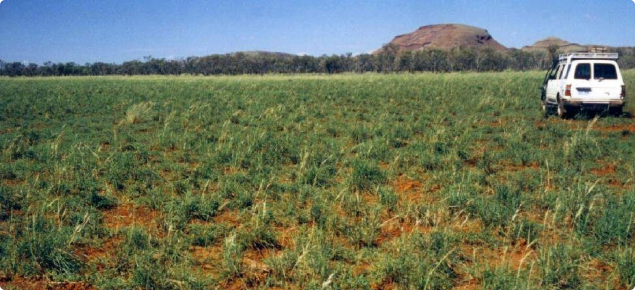Pasture potential
In good condition, the pasture value of ribbon grass pastures is very high. Ribbon grass (Chrysopogon fallax) is palatable and preferred by stock when green but is unattractive when dry. Many of the other grasses, low shrubs, herbaceous perennials and annuals in season which are associated with ribbon grass are also palatable and supply good quality forage for much of the year. Ribbon grass pastures in good condition can support all classes of livestock.
Suggested levels of use (per annum)
- Good condition: 15 hectares per cattle unit (ha/cu)
- Fair condition: 30 ha/cu
- Poor condition: 45 ha/cu
Managing ribbon grass pastures in the Pilbara
Grazing management
Ribbon grass is palatable to stock when green, but when dry, like many grasses, it is not preferred. Ribbon grass pastures on open grassland sites where there are few other useful plants (other than annuals in season) should be grazed for 6 to 9 months rather than year-long. In groves and drainage tracts where the pastures includes a wide range of palatable low shrubs and perennial herbs which hold their forage value, livestock can graze year-round (at appropriate stocking rates).
Repeated heavy grazing and/or a series of dry years will kill ribbon grass. Its seeds appear to last a long time in the ground, as germination can occur without mature plants being present. Seedlings do not persist if grazed heavily. Occasional spelling over a growing season is necessary to maintain good condition.
Surface water management
Use recommended road and track designs suitable for the slope and landscape position, to minimise disruption of water movement. Poor positioning or construction of roads and tracks can interrupt water movement and starve downslope groves and drainage tracts, and erosion gullies drain water from low lying alluvial plains.
Fire management
Fire is useful on pastures with a high proportion of soft spinifex (Triodia pungens) in the stand (e.g. sandy sites in granitic country). We recommend getting local advice about using fire in tussock grasslands on broad alluvial plains, and not using fire on groved sites which support fire-sensitive plants such as mulga (Acacia aneura).
Regeneration
Within the spinifex hummock grasslands, ribbon grass probably once dominated areas receiving flood water, such as sandy drainage floors and minor alluvial plains. Heavy grazing by sheep and kangaroos is the probable cause of reduced ribbon grass on these sites. Destocking, followed by appropriate burning and grazing management can return these areas to ribbon grass and other grasses (Suijdendorp 1967). An area at the old Woodstock Research Station that was 100% soft spinifex in the 1950s but was burnt every five years and spelled for the growing season yearly until seed set, has returned to ribbon grass.
Pasture condition
Traverse data (224 observations) during the Pilbara rangeland survey 1995–97 recorded:
Pasture condition: very good 11%, good 24%, fair 30%, poor 25.5%, very poor 9.5%
Soil erosion: nil 85%, slight 3%, minor 4%, moderate 7%, severe 1%.
Ribbon grass pastures had highly variable condition, with some significant areas in poor or very poor condition. Soil erosion was not widespread but was serious in localised areas on parts of the Cane and Paradise land systems.
Very good – good condition
Good condition (Figure 1, 2, 3) is indicated by a moderately dense to dense population of ribbon grass (Chrysopogon fallax) and associated grasses with basal cover of between 3 and 10%. The lower values are associated with gilgaied groves and flow tracts that also support dense woodlands or shrublands of mulga (Acacia aneura) or other acacias.
These mulga communities also support populations of other shrubs such as cotton bush (Ptilotus obovatus) and Wilcox bush (Eremophila forrestii). Ribbon grass on gilgai plains and alluvial plains can form dense tussock grasslands, without trees or shrubs, where basal cover can reach 10%.
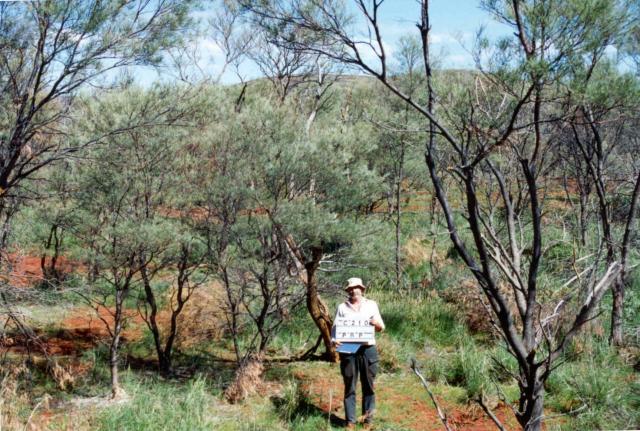
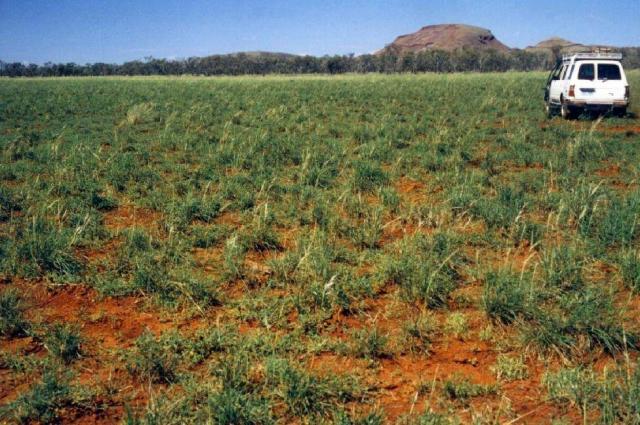
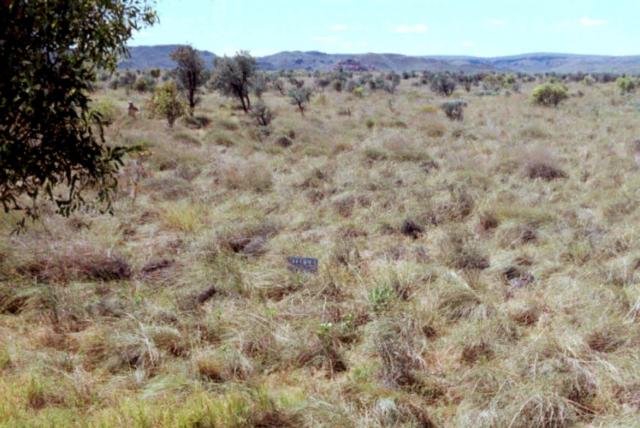
Fair condition
In fair condition (Figure 4), there is a population of ribbon grass with basal cover of between about 1 and 3%. Plants may be patchy in distribution and some may show poor vigour. Populations of associated palatable low shrubs and herbaceous perennials are usually reduced from potential.
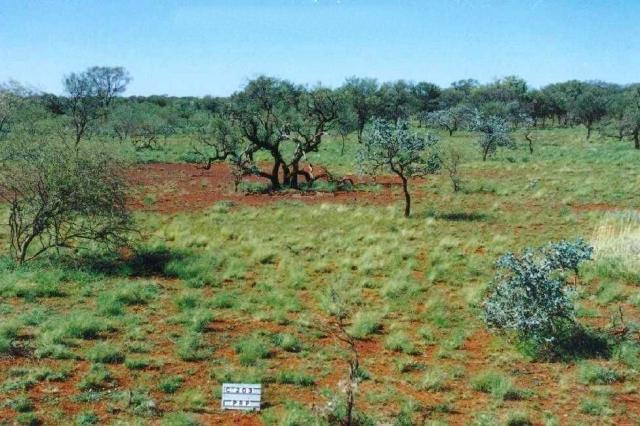
Poor–very poor condition
Ribbon grass pastures with less than 1% basal cover of ribbon grass are regarded as in poor condition (Figures 5, 6). Tussocks may show poor vigour or be moribund. Unpalatable plants such as 12–mile poverty bush (Eremophila lanceolata) and spiked malvastrum (Malvastrum americanum) may increase. In extreme situations ribbon grass is present only as occasional dead relics and there may be soil erosion as surface sheeting and pedestalling of grass butts.
Groves in poor condition will have only a few moribund butts of ribbon grass. Other decreaser grasses and shrubs will be rare or absent beneath the taller mulgas. There is usually no erosion except in extreme situations where nearly all plants, including the mulgas, die and the grove structure collapses.
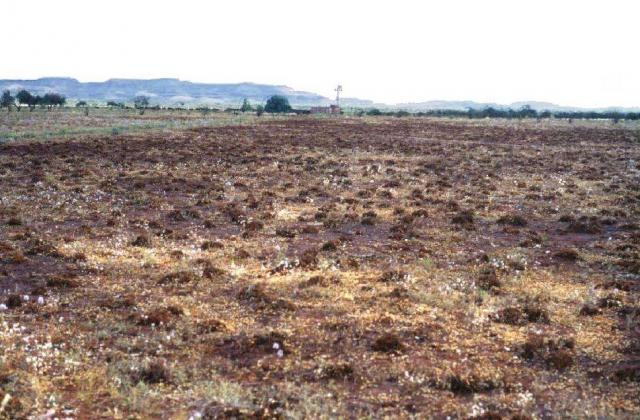
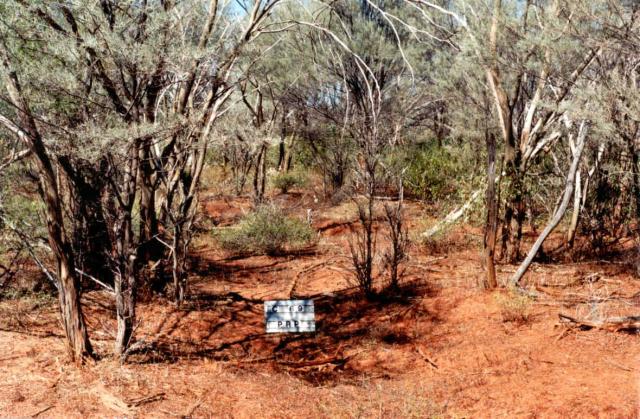
Vegetation structure and composition
The one common feature of this pasture type is a grass layer dominated or co-dominated by ribbon grass (Chrysopogon fallax). In other respects, the vegetation structure and composition is highly variable with different suites of species associated with different habitats and soil types. Structure can be tall shrublands or woodlands with projected foliage cover (PFC) of 10 to 30% on drainage floors or grasslands, with isolated to very scattered trees and shrubs (PFC <2.5%) on alluvial plains.
In gilgaied groves and drainage floors
The tree and tall shrub layer is dominated by mulga (Acacia aneura) with occasional eucalypt trees and corkwood (Hakea suberea). Total PFC is 25% to more than 50%. Common mid height and low shrubs include Wilcox bush (Eremophila forrestii), warty fuchsia bush (Eremophila latrobei), 12–mile poverty bush (Eremophila lanceolata), flannel bush (Solanum lasiophyllum) and creeping sida (Sida fibulifera).
The perennial grass layer with up to 5% basal cover is predominantly ribbon grass but others such as kangaroo grass (Themeda triandra), Roebourne Plains grass (Eragrostis xerophila), neverfail (Eragrostis setifolia) and Digitaria spp. may also occur.
On alluvial plain sites with clay soils
This pasture type is a tussock grassland of ribbon grass commonly with others such as Roebourne Plains grass, neverfail and swamp grass (Eriachne benthamii). Total basal cover can be up to about 10% but is usually much less. A few isolated to very scattered (PFC up to 10%) shrubs such as mimosa bush (Acacia farnesiana), prickly acacia (Acacia victoriae) and cassias (Senna spp.) may be present. Occasionally the total shrub cover may reach 15 to 20%.
On drainage tracts with sandy soils
On granitic terrain of the Macroy land system, this pasture type often has soft spinifex (Triodia pungens) as a companion (sometimes co-dominant). The shrub layers are well developed and much more diverse than on clay sites. They include Acacia, Senna, Cullen, Bonamia and Ptilotus species. The PFC of the shrub layers is variable and dependent on fire history.
Occurrence
Approximate area 1765 km2 (0.9% of total).
This pasture type is found throughout the Pilbara on numerous land units and different soil types. It does not usually occur over areas more than a few kilometres in extent, and frequently as much smaller inclusion (e.g. groves) within other pastures. It is mostly found in run-on positions in the landscape, where it receives additional water shed by overland flow or channelled flow from adjacent surfaces or overbank flooding from rivers and creeks.
Land units which support Ribbon Grass Pasture are:
- crab-holed (gilgaied) groves and drainage tracts in south-central parts of the Pilbara on land systems such as Jurrawarrina, Marillana and Wannamunna – soils are cracking clays and red loamy earths
- some alluvial plains, gilgai plains and levees associated with major rivers on land systems such as Brockman, Cane, Fortescue and Paradise – soils are cracking clays, deep red-brown clays and red sandy earths
- some drainage floors and shallow valleys in granitic landscapes on the Macroy, Stuart and Sylvania land systems – soils are red sandy earths, red loamy earths and sandy duplex types.
Associated plants
| Common name (link to DPIRD species page) | Scientific name (link to FloraBase) | Life form |
|---|---|---|
Decreasers (desirables) | ||
| Chrysopogon fallax | ||
| Eragrotis setifolia | ||
| Eragrostis xerophila | ||
| Eremophila forrestii | ||
| Warty fuchsia bush | Eremophila latrobei | |
| Maireana planifolia | ||
|
| Maireana planifolia x villosa | |
| Ptilotus obovatus | ||
| Rhagodia eremaea | ||
| Mardie clover | Rhyncosia minima | |
| Sida fibulifera | ||
| Themeda triandra | ||
Increasers (undesirables) | ||
| Hop bush | Dodonaea petiolaris | |
| 12-mile poverty bush | Eremophila lanceolata | |
| Spiked malvastrum | Malvastrum americanum | |
|
| Solanum sturtianum | |
Intermediates | ||
| Swamp grass | Eriachne benthamii | |
| Eriachne obtusa | ||
| Flannel bush | Solanum lasiophyllum | |
No indicator value (stability desirables) | ||
| Mulga | Acacia aneura | |
| Acacia tetragonophylla | ||
| Wild lemon | Psydrax latifolia (syn. Canthium latifolium) | |
|
| Corymbia aspera | |
| Coolibah | Eucalyptus victrix | |
| Corkwood | Hakea lorea subsp. lorea (syn. Hakea suberea) |
| Common name (link to DPIRD species page) | Scientific name (link to FloraBase) | Life form |
|---|---|---|
Decreasers (desirables) | ||
| Cenchrus ciliaris | ||
| Chrysopogon fallax | ||
| Dichanthium fecundum | ||
| Eragrostis setifolia | ||
| Eragrostis xerophila | ||
| Tall saltbush | Rhagodia eremaea | |
| Mardie clover | Rhyncosia minima | |
| Sida fibulifera | ||
| Senna artemisioides subsp. oligophylla | ||
Increasers (undesirables) | ||
|
| Acacia glaucocaesia | |
| Prickly acacia | Acacia victoriae | |
| Aristida latifolia | ||
| Poison ivy glory | Ipomoea muelleri | |
| Spiked malvastrum | Malvastrum americanum | |
| Crinkled cassia | Senna artemisioides subsp. helmsii | |
| Straight leaf cassia | Senna sp. ‘Meekatharra’ | |
Intermediates | ||
| Swamp grass | Eriachne benthamii | |
No indicator value (stability desirables) | ||
| Mimosa bush | Vachellia farnesiana (syn. Acacia farnesiana) | |
| Snakewood | Acacia xiphophylla | |
| Conkerberry | Carissa lanceolata | |
| Coolibah | Eucalyptus victrix |
| Common name (link to DPIRD species page) | Scientific name (link to FloraBase) | Life form |
|---|---|---|
Decreasers (desirables) | ||
| Cenchrus ciliaris | ||
| Chrysopogon fallax | ||
|
| Cullen pogonocarpum | |
| Bottle washers | Enneapogon spp. | |
|
| Fimbristylis dichotoma | |
|
| Goodenia microptera | |
| Hop-along grass | Paraneurachne muelleri | |
| Mardie clover | Rhyncosia minima | |
| Bush tomato | Solanum diversiflorum | |
Increasers (undesirables) | ||
| Poverty bush | Acacia translucens | |
| Poison morning glory | Ipomoea muelleri | |
|
| Pluchea tetranthera | |
Intermediates | ||
| Aristida holathera var. holathera | ||
|
| Cullen martinii | |
| Eriachne obtusa | ||
| Triodia pungens | ||
No indicator value (stability desirables) | ||
| Kanji | Acacia inaequilatera | |
| Pindan wattle | Acacia holosericea | |
| Prickly acacia | Acacia victoriae | |
|
| Corchorus spp. | |
|
| Eucalyptus spp. | |
| Wild cotton | Gossypium australe | |
| Corkwood | Hakea lorea subsp. lorea (syn. Hakea suberea) | |
| One leaved indigofera | Indigofera monophylla | |
|
| Indigofera spp. | |
|
| Tephrosia spp. |
Other resources
- Suijdendorp, H 1967, A study of the influence of management practices on spinifex (Triodia pungens), masters thesis, University of Western Australia.
- van Vreeswyk, AM, Leighton, KA, Payne, AL, & Hennig, P 2004, An inventory and condition survey of the Pilbara region, Western Australia, Department of Agriculture and Food, Western Australia, Perth. Technical Bulletin 92.

